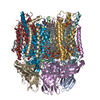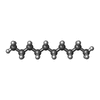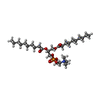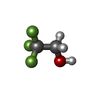[English] 日本語
 Yorodumi
Yorodumi- PDB-8sqw: particulate methane monooxygenase crosslinked with 2,2,2-trifluor... -
+ Open data
Open data
- Basic information
Basic information
| Entry | Database: PDB / ID: 8sqw | |||||||||||||||||||||
|---|---|---|---|---|---|---|---|---|---|---|---|---|---|---|---|---|---|---|---|---|---|---|
| Title | particulate methane monooxygenase crosslinked with 2,2,2-trifluoroethanol bound | |||||||||||||||||||||
 Components Components |
| |||||||||||||||||||||
 Keywords Keywords | OXIDOREDUCTASE / Metalloenzyme / Inhibitor / Membrane Protein / Nanodiscs / Active Site | |||||||||||||||||||||
| Function / homology |  Function and homology information Function and homology informationmethane monooxygenase (particulate) / methane monooxygenase (soluble) / methane monooxygenase [NAD(P)H] activity / monooxygenase activity / metal ion binding / membrane Similarity search - Function | |||||||||||||||||||||
| Biological species |  Methylococcus capsulatus (bacteria) Methylococcus capsulatus (bacteria) | |||||||||||||||||||||
| Method | ELECTRON MICROSCOPY / single particle reconstruction / cryo EM / Resolution: 2.16 Å | |||||||||||||||||||||
 Authors Authors | Tucci, F.J. / Rosenzweig, A.C. | |||||||||||||||||||||
| Funding support |  United States, 6items United States, 6items
| |||||||||||||||||||||
 Citation Citation |  Journal: Nat Catal / Year: 2023 Journal: Nat Catal / Year: 2023Title: Product analog binding identifies the copper active site of particulate methane monooxygenase. Authors: Frank J Tucci / Richard J Jodts / Brian M Hoffman / Amy C Rosenzweig /  Abstract: Nature's primary methane-oxidizing enzyme, the membrane-bound particulate methane monooxygenase (pMMO), catalyzes the oxidation of methane to methanol. pMMO activity requires copper, and decades of ...Nature's primary methane-oxidizing enzyme, the membrane-bound particulate methane monooxygenase (pMMO), catalyzes the oxidation of methane to methanol. pMMO activity requires copper, and decades of structural and spectroscopic studies have sought to identify the active site among three candidates: the Cu, Cu, and Cu sites. Challenges associated with the isolation of active pMMO have hindered progress toward locating its catalytic center. However, reconstituting pMMO into native lipid nanodiscs stabilizes its structure and recovers its activity. Here, these active samples were incubated with 2,2,2,-trifluoroethanol (TFE), a product analog that serves as a readily visualized active-site probe. Interactions of TFE with the Cu site were observed by both pulsed ENDOR spectroscopy and cryoEM, implicating Cu and the surrounding hydrophobic pocket as the likely site of methane oxidation. Use of these orthogonal techniques on parallel samples is a powerful approach that can circumvent difficulties in interpreting metalloenzyme cryoEM maps. | |||||||||||||||||||||
| History |
|
- Structure visualization
Structure visualization
| Structure viewer | Molecule:  Molmil Molmil Jmol/JSmol Jmol/JSmol |
|---|
- Downloads & links
Downloads & links
- Download
Download
| PDBx/mmCIF format |  8sqw.cif.gz 8sqw.cif.gz | 715.5 KB | Display |  PDBx/mmCIF format PDBx/mmCIF format |
|---|---|---|---|---|
| PDB format |  pdb8sqw.ent.gz pdb8sqw.ent.gz | 578.5 KB | Display |  PDB format PDB format |
| PDBx/mmJSON format |  8sqw.json.gz 8sqw.json.gz | Tree view |  PDBx/mmJSON format PDBx/mmJSON format | |
| Others |  Other downloads Other downloads |
-Validation report
| Summary document |  8sqw_validation.pdf.gz 8sqw_validation.pdf.gz | 2.9 MB | Display |  wwPDB validaton report wwPDB validaton report |
|---|---|---|---|---|
| Full document |  8sqw_full_validation.pdf.gz 8sqw_full_validation.pdf.gz | 3 MB | Display | |
| Data in XML |  8sqw_validation.xml.gz 8sqw_validation.xml.gz | 111.7 KB | Display | |
| Data in CIF |  8sqw_validation.cif.gz 8sqw_validation.cif.gz | 146 KB | Display | |
| Arichive directory |  https://data.pdbj.org/pub/pdb/validation_reports/sq/8sqw https://data.pdbj.org/pub/pdb/validation_reports/sq/8sqw ftp://data.pdbj.org/pub/pdb/validation_reports/sq/8sqw ftp://data.pdbj.org/pub/pdb/validation_reports/sq/8sqw | HTTPS FTP |
-Related structure data
| Related structure data |  40714MC  8oyiC  8sr1C  8sr2C  8sr4C  8sr5C M: map data used to model this data C: citing same article ( |
|---|---|
| Similar structure data | Similarity search - Function & homology  F&H Search F&H Search |
- Links
Links
- Assembly
Assembly
| Deposited unit | 
|
|---|---|
| 1 |
|
- Components
Components
-Particulate methane monooxygenase ... , 2 types, 6 molecules AEIBFJ
| #1: Protein | Mass: 42832.887 Da / Num. of mol.: 3 / Source method: isolated from a natural source / Source: (natural)  Methylococcus capsulatus (bacteria) / Strain: Bath / References: UniProt: G1UBD1 Methylococcus capsulatus (bacteria) / Strain: Bath / References: UniProt: G1UBD1#2: Protein | Mass: 27869.459 Da / Num. of mol.: 3 / Source method: isolated from a natural source / Source: (natural)  Methylococcus capsulatus (bacteria) / Strain: Bath / References: UniProt: Q607G3 Methylococcus capsulatus (bacteria) / Strain: Bath / References: UniProt: Q607G3 |
|---|
-Protein , 1 types, 3 molecules CGK
| #3: Protein | Mass: 27656.840 Da / Num. of mol.: 3 / Source method: isolated from a natural source / Source: (natural)  Methylococcus capsulatus (bacteria) / Strain: Bath / References: UniProt: Q603F1 Methylococcus capsulatus (bacteria) / Strain: Bath / References: UniProt: Q603F1 |
|---|
-Non-polymers , 7 types, 419 molecules 












| #4: Chemical | ChemComp-D10 / #5: Chemical | ChemComp-CU / #6: Chemical | ChemComp-PLC / #7: Chemical | ChemComp-P1O / #8: Chemical | ChemComp-HXG / #9: Chemical | #10: Water | ChemComp-HOH / | |
|---|
-Details
| Has ligand of interest | Y |
|---|
-Experimental details
-Experiment
| Experiment | Method: ELECTRON MICROSCOPY |
|---|---|
| EM experiment | Aggregation state: PARTICLE / 3D reconstruction method: single particle reconstruction |
- Sample preparation
Sample preparation
| Component | Name: particulate methane monooxygenase / Type: COMPLEX / Entity ID: #1-#3 / Source: NATURAL |
|---|---|
| Molecular weight | Value: 0.33711 MDa / Experimental value: NO |
| Source (natural) | Organism:  Methylococcus capsulatus str. Bath (bacteria) Methylococcus capsulatus str. Bath (bacteria) |
| Buffer solution | pH: 7.3 |
| Specimen | Conc.: 5 mg/ml / Embedding applied: NO / Shadowing applied: NO / Staining applied: NO / Vitrification applied: YES |
| Vitrification | Cryogen name: ETHANE |
- Electron microscopy imaging
Electron microscopy imaging
| Experimental equipment |  Model: Titan Krios / Image courtesy: FEI Company |
|---|---|
| Microscopy | Model: FEI TITAN KRIOS |
| Electron gun | Electron source:  FIELD EMISSION GUN / Accelerating voltage: 300 kV / Illumination mode: OTHER FIELD EMISSION GUN / Accelerating voltage: 300 kV / Illumination mode: OTHER |
| Electron lens | Mode: OTHER / Nominal defocus max: 2000 nm / Nominal defocus min: 1000 nm |
| Image recording | Electron dose: 50 e/Å2 / Film or detector model: GATAN K3 (6k x 4k) |
- Processing
Processing
| CTF correction | Type: PHASE FLIPPING AND AMPLITUDE CORRECTION |
|---|---|
| 3D reconstruction | Resolution: 2.16 Å / Resolution method: FSC 0.143 CUT-OFF / Num. of particles: 500000 / Symmetry type: POINT |
 Movie
Movie Controller
Controller







 PDBj
PDBj








